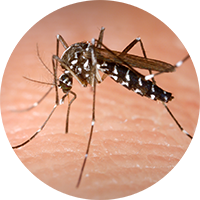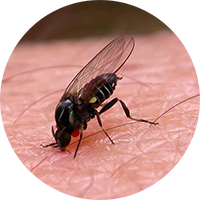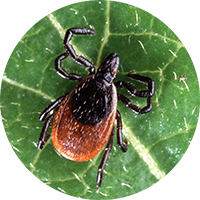Mosquito and MMCD Frequently Asked Questions
1You’re doing a great job, the mosquitoes aren’t bad at all. Why is that? (Or, The mosquitoes are terrible! What are you going to do about it?)
Lots of rain in a short period of time, plus warm temperatures, generally means more mosquitoes. If heavy rainfall is spread over a wide area, it makes it more difficult for us to reach all areas with our larval control during the seven to ten day period before the larvae become adult mosquitoes. Sometimes closely spaced rains will produce more than one brood (or hatch) of mosquitoes in the water at the same time. Consequently, some sites will have to be treated twice, and we may not have enough time and resources to do this. Conversely, normal rainfall or a dry period generally means fewer mosquitoes, and we are better able to keep up with them.
2Will that stuff you’re using hurt me (or my kid, dog, cat, ducks, fish, trees, lawn, garden, etc)?
In general, the answer is no. Our two larvicides, Bti and methoprene, pose no danger to people, pets, or wildlife, even if they drink the water. Of course, for safety we want the kids and animals to stay clear while we are making a treatment. People may be concerned that because we are killing mosquito larvae and adults, we might be depriving wildlife such as ducks and bats of their food. Animals such as ducks and bats do not rely on a single source of food, and will frequently switch diets during the year as different foods become plentiful.
As for adult mosquito spraying, the pyrethroids used by MMCD pose no measurable health risk to humans and animals, but are toxic to fish and bees. This is why we do not spray near water or blooming crops. Permethrin is only applied to dense vegetation where mosquitoes rest during the day, and resmethrin is applied as a fog during the evening when mosquitoes are active but bees are not. All of our materials are registered for use in Minnesota and are among the safest available. As professional applicators we take pride in only making a treatment when necessary, following label directions, and minimizing the potential impacts on non-target species. We live in this area and enjoy the outdoors too, so we take a personal as well as professional interest in protecting the environment.
3Why don’t you do more where I live?
MMCD has divided the Metro Area into two “priority zones.” Priority Zone 1 encompasses most of the population and receives all District services. Priority Zone 2 is the less populated area surrounding Zone 1. This area receives disease surveillance and control (such as the removal of waste tires), blackfly control, tick surveillance, and limited control of larval and adult annoyance mosquitoes.
We prioritize our limited resources to reach the areas with the greatest population density first. We periodically adjust the zone boundaries to keep up with changes in population. If you want specific information about what’s being done around your property, call the Main Office at 651-645-9149.
4What can I do around my house (or cabin) to keep the mosquitoes down?
You can take steps to lessen mosquito annoyance around your home. Remove or empty water-holding containers, trim vegetation where adult mosquitoes rest, avoid going outdoors during dusk and early morning, wear loose light colored clothing, and use repellents and insect control products. Recently, traps which burn propane to produce carbon dioxide to attract mosquitoes have come on the market. There are anecdotal reports that these traps work well in reducing mosquito annoyance in some situations. A number of studies are under way in the US to measure their effectiveness. Permethrin is available in some over-the-counter insect control products. Hand-held foggers powered by electricity or propane which use permethrin can be purchased at home and garden stores. Always read and follow the label when using any repellant or insecticide.
5What about using (bats, birds, citronella plants, bug zappers, etc) to control mosquitoes?
Ultraviolet (black light) electric traps, or bug zappers, are not effective in reducing mosquito annoyance. One study found that mosquitoes comprised only 6.4% of the insects in a five day catch, and only about half of the mosquitoes killed were blood-feeding females. Furthermore, these traps kill large numbers of non-pest insects such as beetles and moths. These insects are beneficial as part of the food chain, and some are natural biological controls on other insect pests.
Devices that claim to repel mosquitoes using high-frequency sound waves are ineffective. Numerous studies have shown that these products have little or no effect on mosquitoes. Citronella plants also have not been proven to effectively repel mosquitoes.
Many people believe that erecting purple martin and bat houses will reduce mosquito populations. However, in-depth studies have shown that mosquitoes comprise no more than 0 to 3% of the diet of purple martins. Likewise, bats are opportunists and will eat a variety of insects. They may eat mosquitoes but will also prey on beetles, moths, leafhoppers, wasps, flies, mayflies, and grasshoppers. They will most likely feed on whatever is most numerous and easiest to catch, and if necessary will travel far from their roosting sites in search of prey. Martins and bats will consume mosquitoes, but are not likely to significantly reduce the population. They should be protected and encouraged because they are interesting residents of the natural environment, not because of their ability to control pest populations.
6Can you spray my yard?
The District does not typically spray private property unless there is the threat of mosquito-borne disease in the area. We may spray a property if the mosquito numbers are high and the treatment will benefit more than one household, but specific requests for private sprays are not guaranteed. Availability of treatment may be affected by many factors, including weather, workload, budget, mosquito numbers, availability of equipment and personnel, and proximity to areas where spraying is not allowed. Citizens may call us to report high mosquito annoyance.
7Where can I buy those control materials?
Our control materials and formulations are designed for use by professional applicators and are quite expensive. Bti is available in various forms at home and garden or farm supply stores. We strongly recommend that citizens contact MMCD first to evaluate their wetlands for mosquito breeding potential. Not all wetlands produce mosquitoes, and treating one small site in your yard won’t do much good if there are other untreated breeding sites nearby.
8I don’t like what you’re doing. Can I say no?
Yes, you can say no. We do have the authority to enter private property to respond to the threat of mosquito-borne disease, but the District has rarely had to invoke this authority.
We can also provide a variety of special responses for citizens. For example, we may be able to establish a buffer around a residence where someone has an allergy to aerosols, or we can notify them before we use the helicopter near their property. If you have questions or concerns, call the Main Office at 651-645-9149.
9Do you work for the DNR or the state?
Neither. We are a local government agency that serves the entire seven county metro area. We are a special taxing district funded by property taxes collected entirely within our service area. In 2020, a property assessed at $250,000 will be charged about $12.00 for mosquito control.
10Can you do anything about horseflies, deer flies, or ticks?
No, our control materials do not affect horse or deer flies, and there is currently no wide-scale economical and environmentally sound way to control ticks. There are repellants for humans that may be effective on horse and deer flies, and your veterinarian or farm supply store can recommend repellants for animals. Repellants, wearing light-colored clothing, and avoiding their habitat are the best way for people to avoid ticks. MMCD monitors deer ticks in the metro area, advises homeowners on landscaping techniques, helps educate the public about Lyme disease, and offers free tick identification, but we don’t control deer ticks.
11What do you do during the winter?
Our larval surveillance and control season starts in February and runs until November. The District hires approximately 180 seasonal Inspectors. Most work from April/May until August/September. There are 53 regular full-time employees who spend the “off season” training, updating and digitizing section maps, compiling and analyzing data, maintaining equipment, conducting educational programs for area students, planning for the next season, and finding ways to improve the program.
12Should I be worried about West Nile Virus?
West Nile Virus (WNV) is transmitted by mosquitoes, and by the end of 2004 it had spread over much of the country. It was detected in Minnesota for the first time in 2002. In 2003 there were 148 human cases of WNV in Minnesota, with four deaths, and in 2004 there were 34 human cases with no deaths. As of the end of 2013, 2,374 cases of West Nile illness had been reported to the CDC. Seventy-nine of those were Minnesota cases, three of which were fatal. Most people who are infected will not experience any symptoms, or may experience flu-like symptoms (West Nile fever) and then recover. In rare cases, the virus may cause West Nile encephalitis with severe symptoms requiring hospitalization. While WNV can affect anyone, risk increases with age. People over 50 are at higher risk to develop serious symptoms.
WNV is here to stay, and MMCD and the Minnesota Department of Health are prepared to do surveillance for the virus and to respond in the event of an outbreak. There is still much to learn about WNV, and we are working in cooperation with agencies and research facilities across North America to find out the best way to deal with it. There is a vaccine available for horses, and we recommend that horse owners consult with their veterinarian. People can reduce their risk of infection simply by reducing their exposure to mosquito bites.



